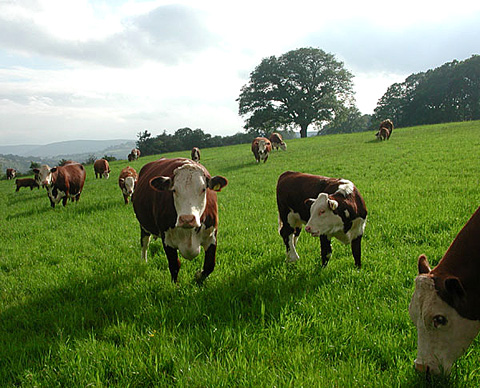
 By Dr. Steve Hammack
By Dr. Steve HammackProfessor & Extension Beef Cattle Specialist Emeritus
Texas A&M University AgriLife Extension Beef Cattle Browsing Newsletter
The following projections have been made for the next couple of years:
* Beef cow numbers are projected to continue to decline so beef supply will also decline.
* Demand for beef is projected to steady.
* Exports are projected to increase; imports are projected to be steady.
* Corn production is projected to increase.
* Value of beef trimmings and the chuck is projected to increase at a higher rate than for rib and loin, continuing the trend of recent years.
* The Choice-select spread is projected to be slightly higher than the last few years.
* Total supply of meat and poultry is projected to decline.
* Cattle and beef prices are projected to increase.
(Cattle-Fax, Dec. 2010)
IS EFFICIENCY THE SAME WHILE GROWING AND FINISHING?
A growing ration (74% oats, 21% grass hay, 5% supplement) and a finishing ration (57% barley, 28% oats, 10% alfalfa, 5% supplement) were used to see if individual feed efficiency was the same on both types of diets. Three years of data were collected involving 490 crossbred steers with two feeding groups each year. Steers averaged approximately 200 days of age and 575 lb at the start of feeding. Feeding was divided into two periods of 70 to 90 days each. One group received the grower ration through both periods, a second group received the finishing ration through both periods, and a third group received the grower ration during the first period but was switched to the finishing ration during the second period. Individual feed consumption was measured throughout the trial.
As expected, ADG was lowest on the grower ration and cattle switched from grower to finisher had the highest ADG of any group while on the finishing ration. Across the three ration regimens, correlation of efficiency between the two feeding periods ranged from 0.22 to 0.46. Individuals were classified as low, medium, or high in efficiency during the two periods. The percentage of individuals that changed efficiency classification between periods by 0.5 standard deviation was 58 for the switched group and 51 for both groups on a constant ration. The latter finding may relate to differences in rate of maturity. As feeding progresses, on a time-constant feeding period, earlier-maturing individuals tend to decline in efficiency more than later-maturing individuals. So, for optimum efficiency, length of feeding should be tailored to maturity pattern.
The authors concluded that a finisher diet should be used to evaluate feedlot efficiency and that lower energy diets than used in this study should be compared to high-energy diets to see if there might be even more re-ranking of efficiency than was measured in the current study. Of even more importance to the overall industry is determining the relationship between efficiency of cows maintained on low- to medium-quality forages and efficiency of their calves finished on high-energy rations. (J. Animal Sci. 89:158; Univ. of Alberta)
CONFINEMENT VS. PASTURE AND TRADITIONAL VS. NATURAL FINISHING OF EARLY-WEANED CALVES
A group of 208 Angus X Simmental steers were weaned at 78 days of age, backgrounded for 38 days and placed on feed for about nine months. Calves were placed on four treatments:
* Confined/Traditional – fed in drylot; received monensin, tylosin, and implants,
* Pasture/Traditional – fed on pasture; received monensin, tylosin, and implants,
* Confined/Natural – fed in drylot; received no additives or implants,
* Pasture/Natural – fed on pasture; received no additives or implants.
Traditional steers were implanted at the start of finishing with Ralgro, 105 days later with Compudose ES, and 91 days later with Component TE-S. Pasture steers grazed (predominantly fescue) at a rate of approximately 1/2 acre/steer, received no hay, and were self-fed.
Compared to confinement, pasture steers were on feed longer, gained slower, ate less feed and had lower feed cost, were more efficient, and had lower total cost even when a pasture charge of $30/hd was included. Confinement steers had fewer Yield Grade 2 and 3 and more Yield Grade 4, higher marbling scores, more Choice carcasses, and higher carcass gross value.
Compared to traditional management, naturally-managed steers gained slower, ate more feed and had higher feed cost, were less efficient, and had higher total cost. Traditional had heavier carcasses, higher marbling, more grading Choice, no difference in Yield Grade, and higher carcass gross value.
Within traditional management, there was little difference between confinement and pasture systems in net financial return. But within natural management, the pasture system had $27 higher net return. Across both systems, traditional management averaged returning $68.50 more than natural management. Therefore, natural management required about $10/cwt carcass premium to break even. (Prof. Anim. Sci. 26:484; Univ. of Illinois)
RED AND PROCESSED MEAT VS. BREAST CANCER
A summary was made of recent research studies evaluating any relationship between consumption of red meat and processed meat and incidence of breast cancer in women. The conclusion was, “red meat and processed meat intake does not appear to be independently associated with increasing risk of breast cancer.” (Nutr. Res. Reviews 23:349; Emory Univ.)
EFFECT OF HIDE COLOR AND SEX CONDITION ON CARCASS TRAITS AND VALUE
A total of 18,575 cattle from 47 feedyards were evaluated at three Texas Panhandle slaughter plants on 37 slaughter dates. There were 83.5% steers and 16.5% heifers. Distribution of hide color was:
* black (50.0%)
* black, white face (10.6%)
* red (10.6%)
* red, white face (5.8%)
* gray (4.9%)
* yellow (4.7%)
* white (3.5%)
* Holstein (2.7%)
* striped (2.4%)
* yellow, white face (2.2%)
* grey, white face (1.4%)
* spotted ( 1.3%)
In analyses, black cattle (combined black and black with white face) were compared to the other hide colors. Black cattle were significantly different (P<0.0001) for all carcass traits as follows:

Heifers had significantly (P<0.0001) lighter carcasses, greater fat thickness, smaller ribeyes (but not lower ribeye/cwt carcass), numerically higher Yield Grades (lower leanness), and higher marbling scores. Carcasses were valued using 2008-2009 average grid discounts and premiums, including those for Certified Angus Beef. (Only 14.5% of the carcasses from black cattle qualified for CAB. Other research has shown that increasing levels of documented Angus genetics results in increased CAB acceptance rate.) Discounts and premiums for Yield Grade and Quality Grade tended to balance such that carcasses from the two primary color groups differed in carcass price by only $0.44/cwt, in favor of the black group. In fact, excluding Holstein the range in carcass price for all hide colors was less than $1/cwt carcass. The same balancing of discounts and premiums was true for steers and heifers, resulting in a difference of only $0.03 in carcass price. Because of higher carcass weight, the black group, and steers, returned higher gross dollars. Other research has confirmed that carcass weight is the most important factor determining gross carcass value. In conclusion, this study showed little difference in carcass price due to hide color or sex condition. (Prof. Anim. Sci. 26:611; West Texas A&M Univ.) EFFECT OF BODY CONDITION AND FORAGE TYPE ON COW PERFORMANCE A group of 227 1/4 to 3/8 Brahman-cross cows grazing endophyte-infested tall fescue (EI) was divided into two groups approximately 5 months before the start of breeding. One group was stocked at approximately one cow per 3/4 acre and the other at approximately one cow per 2 acres. At the start of breeding, the first group averaged Body Condition Score 4.7 (marginal, MG) and the second group averaged BCS 6.6 (good, GD). At the start of breeding, half of each group was switched to grazing coastalbermuda (CB) while the other half continued grazing EI pasture for the 60-day breeding season. During the breeding season, MG CB cows gained 143 lb and increased 0.4 BCS; GD CB cows gained 77 lb but decreased 0.5 BCS; MG EI cows gained 53 lb and decreased 0.1 BCS; GD EI cows gained 24 lb and decreased 0.6 BCS. Calving rates, in the same order, were 84%, 82%, 61%, and 79%. The three higher calving rates were not significantly different (P<0.10), but the MG EI rate was significantly different (P<0.04) from the other three groups. Distribution of calving was not reported. In this study, cows in marginal body condition at the start of breeding performed as well (if managed during the breeding season to allow gain in weight and body condition) as those in good condition. (Other research has shown that cows in poor condition at calving or breeding, below the marginal condition in this study, generally have reduced reproductive performance even if gaining weight during breeding.) The combination of marginal body condition and poor forage resulted in decreased reproductive performance. (J. Animal Sci. 88:4133; USDA-ARS, Univ. of Arkansas) EFFECT OF LIVER ABNORMALITIES ON CARCASS MERIT Over 76,000 carcasses were evaluated to study the impact of liver abnormalities on carcass grade and value. Slightly less than 20 percent of all livers had varying degrees of liver abnormality. Carcasses with normal livers had (P<0.05) higher dressing percent, heavier hot carcass weight, larger ribeyes, greater fat cover, numerically higher Yield Grade (lower leanness), and higher marbling score. Carcass price was not significantly different but carcasses with normal livers had higher gross value due to heavier carcass weight. (J. Animal Sci. 88:4037; West Texas A&M Univ.)
